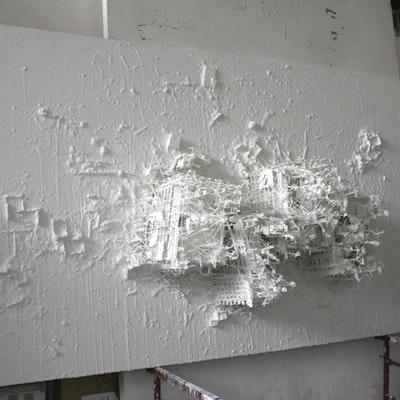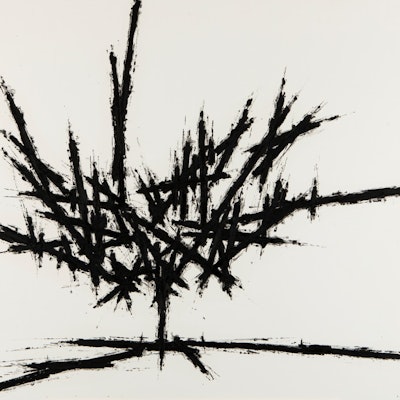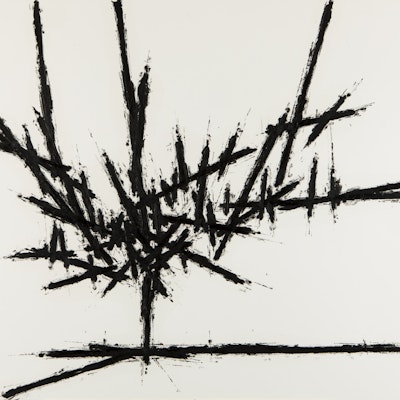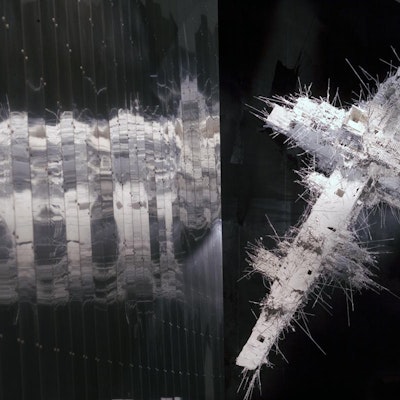Gerry Judah
Currently Showing until 14 February 2025 :
EARTH & ANGELS at 30 Fenchurch Street, Bishopsgate, City of London EC3 .
EARTH : Paintings by Day Bowman. ANGELS : Paintings and Drawings by Gerry Judah. Curated by Jenny Blyth for Brookfield Properties.
There is a shared polarity in the essence of Day Bowman’s and Gerry Judah’s work. Both artists manifest a dynamic and rigorous expression in the execution of their painting that is exciting. Each have a keen enjoyment of architecture and construct, whilst delighting in the deconstruct. Day‘s new paintings that score and scorch the Earth in Marking Out The Boundaries are set against high blue skies, whilst Gerry’s ethereal white Angels capture the ravages of climate change and conflict.
Faith, conflict and climate change have been at the heart of Judah’s work for the past fifteen years. His 3D white-on-white Angels, which document the devastation of war and the ravages to the Earth of climate change, have been shown internationally in museums and galleries with paintings and sculpture placed in public and private collections worldwide.
On Permanent Exhibition :
Sculpture commission secured by Jenny Blyth Fine Art on permanent display at the Imperial War Museum of the North, Manchester : Crusader I was created in direct response to global conflict. It reflects on modern day wars, whilst recalling the history of world conflict such as the faith based Crusades. A powerful and thought-provoking piece, this iconic sculpture comprises a 7 metre three-dimensional crucifix covered with a lattice of war torn buildings lacquered in snow white redolent of the memorial crosses at Flanders Fields. There are a multiplicity of art history references recalling to mind early paintings which celebrated the martyrdom of Saint Sebastian and the ever present Crown of Thorns, to American minimalist giants such as Robert Ryman and Jasper Johns.
Crusader I is the culmination of five years work in which Gerry Judah created a series of three-dimensional paintings of urban decimation focusing particularly on the Middle East and Afghanistan, whilst also responding to environmental damage resulting from natural disasters such as the Tsunami in the Asian Basin, New Orleans in flood ensuing from Hurricane Katrina, and the devastation resulting from earthquakes in Haiti and Iceland. Judah’s work explores construction and deconstruction, decline and regeneration. The setting in Imperial War Museum North’s landmark building - designed by internationally celebrated architect Daniel Libeskind to represent a globe shattered by conflict - is fitting, given the Crusader conceptual references and Judah’s exploration of ‘presence of absence’.
Crusader II & III, Great War Sculptures at St. Paul’s Cathedral since 2014.
Gerry Judah was commissioned to create two sculptures to commemorate the centenary of World War 1 currently on display at St. Paul’s Cathedral.
Selected Past Exhibitions :
Gerry JUDAH at Carey Blyth Gallery, Oxford : October 2021
The breadth of Judah’s works reflects his personal journey with references to the country and city of his early years, Kolkata, and the changes demanded of a country blasted into the 21st Century, that remains firmly steeped in cultural and religious traditions that colour the everyday, the lives of its people, the cities and the landscape.
Drawings and Sculptures in Past and Forward. Monochrome impasto oil pastels manifest as Ark Angels - stellar trees, both rigorous and beautiful. Judah’s sculptures are constructs from clouds to temples mounted onto rickshaws. The engineering is patently hand worked with bindings in steel and bamboo confirming a tradition of making anything and fixing everything. Explosively polarised, as with all Judah’s work, they encompass both Past and Forward, with references past to the beginnings of time, to the Tree of Life, and forward infused with inferences that arise from climate change and conflict.
Judah’s work provides a portal into his perceptions of the changing world. History, politics and environment pervade his compositions. Commissioned by Christian Aid to reflect on issues around the impact of modernity in his home country of Bengal, Judah’s work encompasses an ancient and thriving culture of past, fast forwarded into modernity, where Pujas, Pandals and Tabernacles are as much a part of the landscape of daily life as newbuild factories and industry, with all the fall out associated with progress.
Judah is a Londoner, charged by the architecture of his home turf of more than half a century. Driving across London to his studio, he notes the new buildings, hoardings, and ongoing demolition making space for the new. Excited by the challenges of a continually changing cityscape, it is the geography of his environment that informs his work. It is his constant muse.
His studio in Manor House, North London is a multi-cultural light industrial ‘hive’ of studios teaming with creativity. None more so than Judah’s studio. Drawings for his forthcoming show are framed and glazed, stacked awaiting shipping. The last of his beautiful 3D white paintings are shrouded in plastic - quiet epic ghosts against the walls. Structure for ‘The Ark’ a wall mounted receptacle for Torahs in polished wood commissioned by his local Synagogue is straddled across an expanse of studio floor awaiting construction.
Jenny Blyth Fine Art has been working with Judah since 2003 exhibiting his work in London (see below), placing work in international collections (Saatchi Collection, David Roberts Collection and more) and securing commissions (Imperial War Museum of the North, Wolverhampton Art Gallery…) For exhibition details and images: www.jennyblythfineart.co.uk and www.judah.co.uk
Selected Solo Exhibitions :
Exhibiting with Jenny Blyth Fine Art:
FRONTIERS 2005 at the Timber Yard, Shoreditch, London. Curated by Jenny Blyth.
ANGELS 2006 at the Royal Institute of British Architects, London & British High Commission, India 2007. Curated by Jenny Blyth.
MOTHERLANDS 2007 at the Louise T Blouin Foundation, London. Curated by Jenny Blyth.
COUNTRY 2009 at Wolverhampton Art Gallery, Wolverhampton. Curated by Jenny Blyth.
BABYLON at Flowers East Gallery, London 2009
COUNTRY December 2010 - January 2011 at the Fitzroy Gallery, New York.
Text below by Jenny Blyth © 2013 :
The role for contemporary artists is to react and reflect upon life and the world around us. They may choose to celebrate form and beauty in figuration or abstraction, or perhaps to reflect on the social mores and politics of society. They may share with us a visual diary or preoccupation, coloured by their personal sensibility, or they may choose to express a sense of collective mind. Simultaneously they are creating a distinct artwork that has a unique voice and spirit, which will invite us to share their thoughts or narrative, whilst also exploring our own.
Gerry Judah’s paintings are a direct response to conflict across the globe, and the impact of that violence, whether it is the consequence of war or natural disaster. At the same time, he is fascinated by changing urban landscape, and his paintings explore the dynamic of construction and destruction. It is hard to look at his work without reflecting on conflict in the Middle East whether that be Afghanistan, Iraq, or recent months in Gaza. There are also echoes of the devastation ensuing from climate change wrought by hurricanes, tsunamis, flooding and bushfires that remind us of New Orleans underwater, or the aftermath of the Tsunami in the Asian Basin. Although on first inspection, Judah’s epic landscapes articulate global concerns for peace, he acknowledges the dangers of man’s impact on a finely balanced global ecology, and the decimation that unravels as we exploit the planet with an ever growing appetite.
Aesthetically, Judah composes a score that is made up of light and shadow. The fragility and delicacy of his work is at odds with the force and consequence of the concepts that drive him. Despite the darkness of his subject matter, he creates an explosion of light permeated with an ethereal quality reflecting the cadences and vortices of shattered architecture that we witness in daily media reports. His apocalyptic settlements constructed from scores of buildings, complete with internal structures, communications and water towers are fixed onto canvas, and then systematically destroyed. The ensuing rubble and detritus are scattered and fused onto a background of empty white canvas with layers of acrylic gesso to create silent ‘white on white’ abstract paintings.
Transcending issues of politics, race and culture, Judah creates an abstracted and disturbing aesthetic that is both mellifluous and pertinent, where the ‘presence of absence’ and loss is palpable, and we are confronted with the reality and urgency to seek solutions.
BIOGRAPHY
Gerry Judah was born in 1951 in Calcutta, India and grew up in West Bengal before his family moved to London when he was ten years old.
Judah studied Foundation Art and Design at Barnet College of Art (1970–1972) before obtaining a First-Class Honours degree in Fine Art at Goldsmiths College, University of London (1972–1975) and studying sculpture as a postgraduate at the Slade School of Fine Art, University College London (1975–1977).
He went on to build a reputation for innovative design, working in film, television, theatre, museums and public spaces, creating settings for productions at the Royal Opera House, English National Opera, Royal Festival Ballet, London Contemporary Dance, Royal Ballet, Royal Shakespeare Company, Royal National Theatre, BBC, British Museum, Natural History Museum, Imperial War Museum, Paul McCartney, Michael Jackson, and Led Zeppelin. He has also designed spectacular sculptures for the annual Goodwood Festival of Speed and bridges in London and Cambridge.
COLLECTIONS
Gerry Judah’s work has been exhibited at the Whitechapel Art Gallery, Camden Arts Centre and Yorkshire Sculpture Park and has entered many international public and private collections including: Saatchi Collection London; Anita and Poju Zabludowicz Collection London; Imperial War Museum London & Manchester; Essy & Fatima Maleki Collection London; David Roberts Collection London; Chris Drake Collection Sussex; Centre for Arts Israel; Irena Hochman Collection New York; Bobby Kapoor Collection India; Museum of Old and New Art Australia ; The Earl of March, Goodwood, and International Collections worldwide in Europe, USA, Middle East and Australia.








